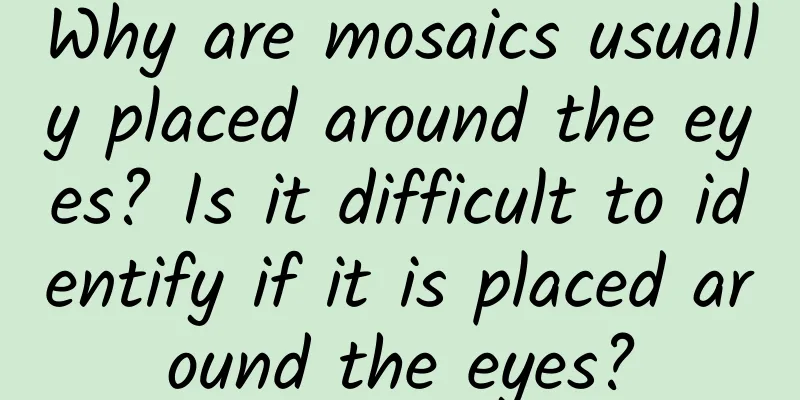Why are mosaics usually placed around the eyes? Is it difficult to identify if it is placed around the eyes?

|
You must have noticed that in some cases where you need to omit a person's face, you will usually see mosaics placed around the subject's eyes. Why is it usually the eyes rather than other parts of the face, such as the nose and mouth? Does mosaicing the eyes make it impossible to recognize the person? Today, let's talk about this issue. 01. Where are mosaics usually applied? Since its invention, mosaic has brought great convenience (or inconvenience) to our lives. It can be said that everyone, from the age of 99 to the youngest, from a financial expert on Wall Street in New York to a native African, has seen mosaics. Mosaic is used so widely, I wonder if you have ever noticed, where is the mosaic often used? ? ? If you think about it carefully, you will find that mosaics are basically placed in two places: 1: Sensitive parts. This usually involves sex, and if it is not mosaiced, it will become an FBI warning. 2: Eyes. This is a more common mosaic coding method, which is to apply it to the face, or more precisely, the eyes. We can understand applying it to the face, after all, the face is the main distinguishing feature of the human body, and it is basically difficult to identify a specific person without the face. But why choose to apply it to the eyes instead of other places on the face? 02. Why are mosaics placed on the eyes? There is a reason why mosaics are placed on the eyes. First of all, the eyes are the key feature of the face. Our face has several structures, from top to bottom they are the forehead, eyes, nose, lips and face. Among these structures, the eyes are the most key feature, because the eyes themselves are changeable, not only the pupil color is different, but also the shape of the eyes, and the most important thing is the eyes. Just like what everyone says, "Give you a look and experience it yourself", the movement of the eyes can convey many thoughts of the human body, such as joy and sadness, such as command information, etc., so some people say that the eyes are the windows to the soul (1). Second, eye size remains relatively constant. I believe you must have a deep memory of the big eyes of children, right? However, as we age, our eyes seem to get smaller and smaller. If we still have "a pair of beautiful big eyes" when we grow up, it would be a great appearance advantage. But this observation is actually wrong. Because the eyes are a very strange organ in our human body, that is, their size changes little. The eyeball of a baby is 16-17 mm, and it is only 22.5-23 mm when it grows up. Moreover, after the age of 13, it is fully developed and remains unchanged, with a change of only about one-third. In contrast, other parts of our body, such as height, increase several times from infant to adult. Therefore, children's eyes appear particularly large relative to their small bodies, and small relative to adults' eyes (2). It is precisely because eyes have obvious diverse information and can maintain relative stability that people choose to use eyes as a criterion when judging others. Once the eyes are covered, it is difficult for us to recognize the person, which is also the reason why mosaics are placed on the eyes. Of course, the same principle applies to those celebrities who wear sunglasses when they go out. With their eyes covered, they are basically unrecognizable except for their die-hard fans. 03. Is Mosaic related to iris recognition? However, some curious kids will definitely think of another important content, which is iris recognition. In various movies and TV dramas, we often see people putting their eyes close to a device before they can turn on a switch or unlock related equipment. This is iris recognition. What is iris recognition? The appearance of the human eye is composed of three parts: the sclera, the iris, and the pupil. The iris is a circular area between the sclera and the pupil, accounting for about 65% of the total area of the eye. The iris contains a wealth of biological feature information, and after being fixed in childhood, it remains unchanged throughout life. It can be said to be a person's lifelong ID card (3). Because of this, the iris is used as one of the important indicators of human biometrics. Compared with DNA identification, which has high sampling difficulty and slow identification, iris recognition has many advantages such as speed and accuracy, and has become an important means of individual identification. So, are mosaics related to iris recognition? The answer is no. We can use a simple example to disprove this point. For example, many people like to wear cosmetic contact lenses, but it does not affect others' recognition of them. Furthermore, in fact, our face recognition does not have such high requirements on the eyeball itself. The most intuitive thing is that if a person closes his eyes, can we recognize him? The answer is yes. For example, the picture below shows a movie star. Even if he closes his eyes, I believe most people who follow the drama can recognize this person. However, if the star's eyes are blurred, it will be difficult to recognize them. This shows that human recognition of faces relies more on the information of the eyes rather than the content of the eyeballs. At this point, we need to make a brief summary: the reason why mosaics are placed on the eyes is that the eyes are an important part of the face that has a distinguishing effect. Blurring this part will make it difficult for people to recognize each other. However, this recognition is mainly based on the overall part of the eyes, not the eyeballs. Of course, it must be pointed out that this recognition is only a person's recognition of others. If it is replaced by a machine, it is another matter. After all, for a machine, judging a person's eyes is an important step. Once a person closes his eyes, the machine will be easily blinded. References: 1. Dang Deyu, Wu Haibin, Wang Runhui. An eye location algorithm for face recognition[J]. Computer Applications and Software, 2005(12):115-117. 2. Cunningham, edited by Paul Riordan-Eva, Emmett T. (2011-05-17). Vaughan & Asbury's General Ophthalmology (18th ed.). New York: McGraw-Hill Medical. 3. Li Jin, Li Shengguang, Zhou Qianli. Research on database construction for large-scale application of police iris recognition[J]. Journal of Chinese People's Public Security University (Natural Science Edition), 2018, 24(02): 57-62. |
<<: The Bass of the Universe: The Ensemble of the Milky Way's Most Mysterious Objects
Recommend
APP user growth: How to use data analysis to improve user growth?
How can we make our APP stand out among a large n...
Is Apple making another big move? Thousands of apps removed from shelves at the same time? !
In the afternoon, one WeChat message and one phon...
ROM Features Comparison
In addition to the rich applications that smartpho...
Anyone can get tuberculosis? Blame this stubborn household!
Mixed Knowledge Specially designed to cure confus...
If a giant planet hits the Earth in 100 years, where will humanity go?
The probability of this assumption is extremely s...
Operating systems other than iOS, Android, and WP?
[[138339]] Sources revealed that Samsung will use...
When she brought out a "Mahjong" at the Olympics, I felt that this was not a simple matter...
yesterday The 2022 Winter Olympics in Beijing 100...
Uncle Wolf's Tik Tok Popular Traffic Monetization Secrets 1.0
Uncle Wolf's Tik Tok Popular Traffic Monetiza...
"91 Ten Articles" - A daily must-read briefing for the new energy vehicle industry (210310)
1. Motorcycle company Dayun recently announced th...
IE browser market share plummeted 55% year-on-year: users abandoned it one after another
In the past, IE browser has always been "rest...
The bulge in your buttocks may not be your wallet? Beware of the pain deep inside your buttocks!
1. What is “thick wallet syndrome”? In the past, ...
5 core steps to acquire app users
Many startups are interested in trying to discove...
90% of copywriters often make these three mistakes. Have you made any of them?
We always study how successful copywriting is wri...
"Crossing the river by feeling one's way across", he is the first person in China to study and protect fireflies
The scene of chasing fireflies on summer nights i...









